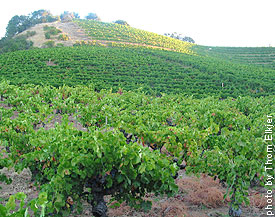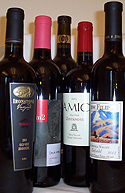

Russian River Zins grow big on the vine and now, with a few exceptions, seem to be big in the bottle as well.
Classic Russian River Zinfandel
There are few of the classic, lower alcohol Zins left in this prime Zinfandel growing area. A few remain and they are worth seeking out. The other Zins are hot - both in style and in popularity.
by
Dan Berger
January 31, 2007
Decades ago (seems like yesterday to me), we bought Zinfandels that were 13.9 percent alcohol. We called them “late harvest”. Regular Zinfandel of the day was 13.0 percent; a few were lower than that. Occasionally Ridge made a monster; one was called Ridge Essence. It had some residual sugar from a stuck fermentation, and the flavors were not really over-ripe and port-y.
Today, that’s all changed. Just try finding one these days at 13.9 percent alcohol. They’re dinosaurs. Big is in. And Zin is hot only if it’s h-o-t. Zinfandel is known as an erratic-ripening grape. Late in the season, when Cabernet Sauvignon and Zin are some of the last grapes left on the vine, Cabernet is happy to turn a dusty blue-ish color. But look over there at the Zin. Green berries remain amid the raisins. That’s erratic.
Fearful that a small amount of green berries would give them a
Older vines supposedly make the best wine, though that “fact” may be more folklore than reality. But to be sure, older vines have a vineyard character that many wine makers love to focus on and highlight in their special bottlings—if, that is, the grapes are picked at moderate sugar levels. At very high sugar levels, vineyard character seems to be compromised. As is terroir.
Russian River Valley is a cool place. Cool enough to ripen Pinot Noir and Chardonnay, and to allow Sauvignon Blanc and Gewurztraminer to be made with regional characteristics. There is a good deal of Russian River Zin out there, and in the 1970s and early 1980s, much of it was distinctive with a racy peppery note indicating its cool-climate up-bringing. However, as wine makers began to worry more about that chance of a green or herbal note in their wines, and to insure utter ripeness, notably on soils that are a tad more fertile than in the hardscrabble hills, they waited. Patience is a virtue in many situations. Not here.
Hanging grapes on the vine for a long period of time insures only over-ripe flavors. But, they argued, picking early means dealing with higher-than-normal acid levels, something completely unacceptable to consumers. The operative word here is “normal,” and what was considered normal two and three decades ago was seen as too high for today’s consumer, who has been taught to appreciate only softer, suppler wines.
And thus it is that Russian River, with its more acid-leaning Zinfandel grapes, is a region for the older consumer -- a consumer who appreciates the crisper, more claret-like style of Zin. It is a wine which evokes memories of black fruit like blackberries; hints of fresh strawberries and even raspberries, and almost mulberry notes. But many riper versions have come along in the last decade, even though they do not reflect Russian River Valley character. The plum, near-raisin, almost port-ish expression of such wines is not “classic” in the sense that many of the older wines once delivered.
So the dwindling number of Russian River Zins which contain the lean, delicate notes of the past, such as those from Gary Farrell, Joseph Swan, and Dutton Goldfield, still offer a more food-oriented style of wine; one which simply does not show off its attributes early or as readily as those from other, warmer regions where the soils are more weathered sandstone and deliver redder flavors.
Sad to say, but an entire generation has been left with few examples of the classic cool-climate message of the past.
~ Dan Berger, Editor at Large
To comment on Dan’s writings and thoughts, contact him at d.berger@appellationamerica.com
Today, that’s all changed. Just try finding one these days at 13.9 percent alcohol. They’re dinosaurs. Big is in. And Zin is hot only if it’s h-o-t. Zinfandel is known as an erratic-ripening grape. Late in the season, when Cabernet Sauvignon and Zin are some of the last grapes left on the vine, Cabernet is happy to turn a dusty blue-ish color. But look over there at the Zin. Green berries remain amid the raisins. That’s erratic.
Fearful that a small amount of green berries would give them a
Many wine makers over the decades have carved out a different niche for Zin. They have gone for more intensity, offering deeper flavors, even though some of those flavors are more like Port or, more precisely, raisins.
note of herbs in the final wine, many wine makers over the decades have carved out a different niche for Zin. They have gone for more intensity, offering deeper flavors, even though some of those flavors are more like Port or, more precisely, raisins. And that has led to much higher alcohol levels; 15.5 percent isn’t all that uncommon these days. Along the way, consumers have learned to deal with the heat and sweetness that such wines offer.
Older vines supposedly make the best wine, though that “fact” may be more folklore than reality. But to be sure, older vines have a vineyard character that many wine makers love to focus on and highlight in their special bottlings—if, that is, the grapes are picked at moderate sugar levels. At very high sugar levels, vineyard character seems to be compromised. As is terroir.
Russian River Valley is a cool place. Cool enough to ripen Pinot Noir and Chardonnay, and to allow Sauvignon Blanc and Gewurztraminer to be made with regional characteristics. There is a good deal of Russian River Zin out there, and in the 1970s and early 1980s, much of it was distinctive with a racy peppery note indicating its cool-climate up-bringing. However, as wine makers began to worry more about that chance of a green or herbal note in their wines, and to insure utter ripeness, notably on soils that are a tad more fertile than in the hardscrabble hills, they waited. Patience is a virtue in many situations. Not here.
Hanging grapes on the vine for a long period of time insures only over-ripe flavors. But, they argued, picking early means dealing with higher-than-normal acid levels, something completely unacceptable to consumers. The operative word here is “normal,” and what was considered normal two and three decades ago was seen as too high for today’s consumer, who has been taught to appreciate only softer, suppler wines.
And thus it is that Russian River, with its more acid-leaning Zinfandel grapes, is a region for the older consumer -- a consumer who appreciates the crisper, more claret-like style of Zin. It is a wine which evokes memories of black fruit like blackberries; hints of fresh strawberries and even raspberries, and almost mulberry notes. But many riper versions have come along in the last decade, even though they do not reflect Russian River Valley character. The plum, near-raisin, almost port-ish expression of such wines is not “classic” in the sense that many of the older wines once delivered.
 Explore the diversity of Zinfandel with Appellation America!
Explore the diversity of Zinfandel with Appellation America!
Regionally distinctive Zins from close to 20 different appellations now available in the Appellation America online wine store.
So the dwindling number of Russian River Zins which contain the lean, delicate notes of the past, such as those from Gary Farrell, Joseph Swan, and Dutton Goldfield, still offer a more food-oriented style of wine; one which simply does not show off its attributes early or as readily as those from other, warmer regions where the soils are more weathered sandstone and deliver redder flavors.
Sad to say, but an entire generation has been left with few examples of the classic cool-climate message of the past.
~ Dan Berger, Editor at Large
To comment on Dan’s writings and thoughts, contact him at d.berger@appellationamerica.com













